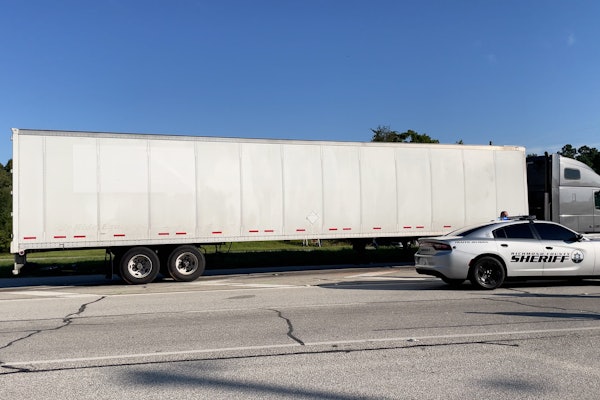(EDITOR’S NOTE: This is Part 3 of the CCJ coverage from the “All About the Driver” panel discussion Oct. 22 at the American Trucking Associations Management Conference and Exhibition in Orlando. Part 1, featuring a debate on hourly pay for drivers, is here. Part 2, on the impact of hours-of-service changes, is here.)
With experienced truck drivers harder and harder to come by, carriers increasingly are turning to driving schools and beefing up their own finishing programs. But, as a panel of fleet executives concluded, top-of-line training and eye-popping recruiting budgets go to waste if trucking companies don’t take a little extra time to make sure drivers, experienced or not, are able to adjust and get comfortable with a new home.
Ideas on recruiting and retention, along with driver pay and the impact of recent hours of service changes were tossed around last week during a driver-focused session at the annual American Trucking Associations Management Conference and Exhibition in Orlando.
 To fill empty seats, more carriers are hiring drivers fresh from training schools.
To fill empty seats, more carriers are hiring drivers fresh from training schools.ATA Chief Economist Bob Costello laid the groundwork for the discussion by presenting the results of his new survey, an industry “snapshot” of the driver market as assessed by “a good mix” of 200 fleets.
“I couldn’t believe how consistent the data was,” Costello said, prefacing the presentation. “And it really drives home the point that all these folks are having trouble recruiting drivers.”
From the survey, 100 percent of medium-sized truckload and intermodal carriers said they were struggling to find qualified drivers; that’s the high end compared to the industry overall, at “only” 82 percent. And 89 percent of large TLs reported that finding drivers is even more difficult now than it was a year ago.
The upshot is that 78 percent of those large TL carriers are hiring drivers with no experience, compared to an industry average of 26 percent. But of those fleets that currently do not hire drivers with no experience, almost 40 percent are “seriously” considering it, Costello reported.
Derek Leathers, president and COO of Werner Enterprises, said his company’s history of hiring drivers straight out of a CDL program “goes back a long ways.”
“There’s a reason that large fleets tend to do more of it: It really is a numbers game. We have more seats that we have to fill, so we have to have a more diverse approach,” Leathers said. “We’re not a student-only fleet by any stretch of the imagination, but at the same probably two out of every three drivers we hire either come with minimal experience or come out of a driver training school and we have to put them through a finishing program. We’ve been doing it for 25-plus years.”
Taking on drivers with no experience can be “painful” to get into, Leather cautioned, with “lots of bumps in the road.” But the industry has little choice.
“We have a huge demographic issue, in terms of the number of drivers coming in versus those that are retiring,” he said. “So it’s never been more critical that we find and train future drivers for the industry. The large carriers’ commitment to the school program is one way that happens.”
Leathers emphasized the importance of working with the driving schools to develop the curriculum and streamline the transition into the fleet. Specifically, carrier finishing programs need to be tailored so that new drivers receiver “a healthy dose” of a real-world introduction to trucking.
“I don’t mean the mechanical side. I don’t mean the driving side,” he said. “I mean the industry orientation into the lifestyle they’re entering.”
According to his understanding of the data, those new CDL holders skew the turnover numbers.
“It’s not so much large truckload carriers are at 99 percent and mid-sized carriers at 80 percent; it’s really those that hire students are at 99 percent and those that don’t at a lower number,” he said. “What you see is a student turnover rate that’s well into the 100s, usually north of 200 percent in the first 90 days. Once they settle in the fleet, it calms down and they’ll be with you for a long time.”
A company-wide commitment is required to help new drivers get through those first 90 days, Leathers explained, adding that even drivers with only six months behind the wheel have been through the “glitches” and know what to expect: a loading problem, a dispatch mix-up, a customer claim.
“You have to literally hold their hands at a significantly higher level than what you do with an experienced driver. Those little things are very alarming to a new driver – and they have enough to worry about already, just trying to be safe and drive the truck appropriately,” Leathers said. “We have to build separate programs around them, little incubation points, so that they’re interacting at the company with a different set of individuals, with a different amount of empathy on our end.”
Steve Gordon, COO of Gordon Trucking Inc., said 90 percent of his company’s new hires are experienced drivers.
He agreed with Leathers on the 90-day window, and said while the problem is “more acute” with students, carriers face similar problems with experienced drivers who run into unexpected problems early with a new company.
“It takes time to build credibility with any new hire. Think about how difficult that is with a driving job, with a person who doesn’t show up at the office every day,” Gordon said. “Somebody who is new has no frame of reference – you, the carrier, have no money in the credibility bank to say things will be better,” Gordon said. “They may get frustrated with our approach, maybe it’s different from where they were previously. They don’t like how the truck is governed. They don’t like the mobile comm system. There’s a ton of aggravators out there people will look at, and say, ‘this just isn’t what I signed up for.’ It’s easier for them to do that in the first 90 days.”
As for recruiting experienced drivers, Gordon Trucking uses a sign-on bonus as one its tools – but Gordon admitted that he wasn’t sure if they were effective.
“It’s kind of become the minimum entry stakes into the recruiting wars. We use them in a targeted fashion,” he said. “We’ll move those chips around on the table based on where our needs are.”
Gordon characterized the sign-on pay as “a transitional package,” designed to put some money in a driver’s pocket to get him through orientation and take some of the pressure off of his first 90 days.
“We do it in stages to help augment their income, rather than just saying ‘come sign with us and we’ll give you a check,” he said.
Gordon Trucking tries to use the range of its operations as a retention advantage as well, making sure that drivers understand the variety of opportunities within the fleet.
“I wish we could sell that as readily on the recruiting side, but it’s really hard for a recruiter to walk somebody through it who hasn’t seen how we operate and hasn’t built a level of trust,” he said.
Gordon suggested that leveraging the culture of a family-owned company is the key to retention for Gordon Trucking.
“We have momentum with a core group of drivers that spreads the gospel. That’s a huge advantage for smaller carriers, that they’re more easily connected to their drivers. As you get bigger, that’s one of the diseconomies of scale: You get further away from the folks doing the work,” Gordon said. “We certainly have competitive pay, great customers, good equipment, but that’s all pretty easy to replicate from a competitive standpoint. We’ve built up that culture where people care, people are approachable. We specifically target safety – trying to find the safest drivers and keep them in our fleet. Drivers that stay with us really appreciate our focus on safety.”
Leathers conceded that “there’s no silver bullet” when it comes to driver retention. Pay, equipment, incentives, benefits, and home-time are all part of any attractive package.
“As an industry that gets infatuated with sign-on bonuses and things of that nature, we end up creating our own churn as drivers jump fleet to fleet to fleet. And we’ve all experienced this 90-day phenomenon where you’re trying to inculcate them into your culture and they’re in the cab of truck half-way across America,” Leathers said. “It’s very difficult to do. That’s where the turnover is at its worst. To the extent that we can settle them within the first 90 days, that’s probably the single most important way to impact turnover.”










